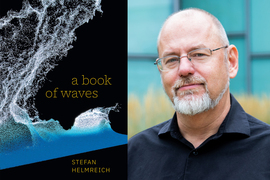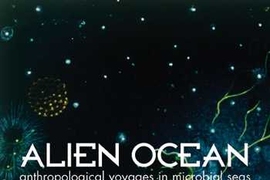Ocean waves are easy on the eyes, but hard on the brain. How do they form? How far do they travel? How do they break? Those magnificent waves you see crashing into the shore are complex.
“I’ve often asked this question,” the eminent wave scientist Walter Munk told MIT Professor Stefan Helmreich several years ago. “If we met somebody from another planet who had never seen waves, could [they] dream about what it’s like when a wave becomes unstable in shallow water? About what it would do? I don’t think so. It’s a complicated problem.”
In recent decades scientists have gotten to know waves better. In the 1960s, they confirmed that waves travel across the world; a storm in the Tasman Sea can create great surf in California. In the 1990s, scientists obtained eye-opening measurements of massive “rogue” waves. Meanwhile experts continue tailoring a standard model of waves, developed in the 1980s, to local conditions, as data and theory keep influencing each other.
“Waves are empirical and conceptual phenomena both,” writes Helmreich in his new work, “A Book of Waves,” published this month by Duke University Press. In it, Helmreich examines the development of wave science globally, the propagation of wave theory into other areas of life — such as the “waves” of the Covid-19 pandemic — and the way researchers develop both empirical knowledge and abstractions describing nature in systematic terms.
“Wave science is constantly going back and forth between registering data and interpreting that data,” says Helmreich, the Elting E. Morison Professor of Anthropology at MIT. “The aspiration of so much wave science has been to formalize and automate measurement so that everything becomes a matter of simple data registration. But you can never get away from the human interpretation of those results. Humans are the ones who care about what waves are doing.”
“You need the world”
Helmreich has long been interested in ocean science. His 2009 book “Alien Ocean” examined marine biologists and their study of microbes. In 2014, Helmreich presented material that wound up in “A Book of Waves” while delivering the Lewis Henry Morgan lectures at the University of Rochester, the nation’s oldest anthropology lecture series.
To research the book, Helmreich traveled far and wide, from the Netherlands to Australia, among other places, often embedding himself with researchers. That included a stint on board the FLIP ship, a unique, now-retired vessel operated by the Scripps Institution of Oceanography, which could turn itself from a long horizontal vessel into a kind of giant live-aboard vertical buoy, for conducting wave measurements. The FLIP ship is one of many distinctive wave science tools; as the book draws out, this has been a diverse and even quirky field, methodologically, with wave scientists approaching their subject from all angles.
“Ocean and water waves look very different in different national contexts,” Helmreich says. “In the Netherlands, interest in waves is very much bound up with hydrogical engineers’ desires to keep the country dry. In the United States, ocean wave science was crucially formatted by World War II, and the Cold War, and military prerogatives.”
As it happens, the late Munk (1917-2019), who The New York Times once called “The Einstein of waves,” developed some of the insights and techniques that helped to forecast wave heights for the Allied invasion of Normandy in World War II. In spinning out his thought experiment about aliens to Helmreich, Munk was making the case for empiricism in wave science.
“Mathematical formalisms and representations are vital to understanding what waves are doing, but they’re not enough,” Helmreich says. “You need the world.”
Disney makes waves
But as Helmreich also emphasizes in his work, wave science depends on a delicate interplay between theory, modeling, and inventive empirical research. What might the Disney film “Fantasia” have to do with wave science? Well, movies used to rely on optical film recordings to play their soundtracks; “Fantasia’s” film soundtrack also had schematic renderings of sound levels. British wave scientists realized they could adapt this technique of depicting sound patterns to represent sets of waves.
For that matter, by the 1960s, scientists also began categorizing waves into a wave spectrum, sorted by the frequency with which they arrived at the shore. That idea comes directly from the concept of spectra of light, radio, and sound waves. In this sense, existing scientific concepts have periodically been deployed by wave researchers to make sense of what they already can see.
“The book asks questions about the relationship between reality and its representations,” Helmreich says. “Waves are obviously empirical things in the world. But understanding how they work requires abstractions, whether you are a scientist at sea, a surfer, or an engineer trying to figure out what will happen at a coastline. And those representations are influenced by the tools scientists use, whether cameras, pressure sensors, sonar, film, buoys, or computer models. What scientists think waves are is imprinted by the media they use to study waves.”
As Helmreich notes, the interdisciplinary nature of wave science has evolved. Physics shaped wave science for much of the 20th century. More recently, as scientists recognize that waves transmit things like agricultural runoff and the aerosolized signatures of coastal communities’ car exhaust, biological and chemical oceanographers have entered the field. And climate scientists and engineers are increasingly concerned with rising sea levels and seemingly bigger waves.
“Ocean waves used to belong to the physcists,” Helmreich says. “Today a lot of it is about climate change and sea level rise.”
The shape of things to come
But even as other fields have fed into ocean wave science, so too has wave science influenced other disciplines. From medicine to social science, the concept of the wave has been applied to social phenomena to help organize our understanding of matters such as disease transmission and public health.
“People use the figure of the wave to think about the shape of things to come,” Helmreich says. “Certainly we saw that during the Covid pandemic, that the wave was considered to be both descriptive, of what was happening, and predictive, about what would happen next.”
Scholars have praised “A Book of Waves.” Hugh Raffles, a professor and chair of anthropology at The New School, has called it “a model of expansive transdisciplinary practice,” as well as “a constant surprise, a mind-opening recalibration of the ways we assemble nature, science, ethnography, and the arts.”
Helmreich hopes readers will consider how extensively social, political, and civic needs have influenced wave studies. Back during World War II, Walter Munk developed a concept called “significant wave height” to help evaluate the viability of landing craft off Normandy.
“There’s an interesting, very contingent history to the metric of significant wave height,” Helmreich says. “But one can open up the concept of significance to ask: Significant for whom, and for what? Significance, in its wider cultural meaning is about human projects, whether to do with warfare, coastal protection, humanitarian rescue at sea, shipping, surfing, or recreation of other kinds. How waves become significant is an anthropological question. “A Book of Waves” seeks to map the many different ways that waves have become significant to people.”










